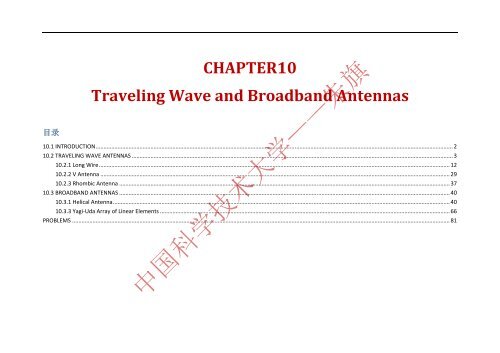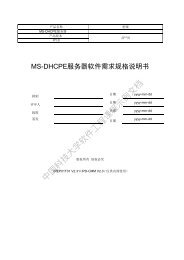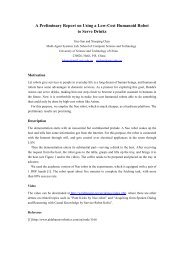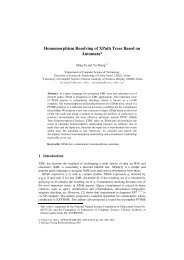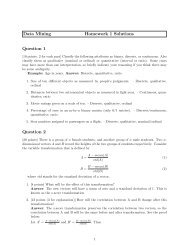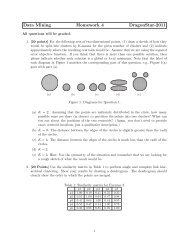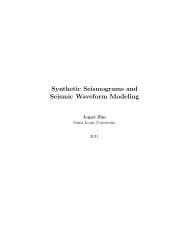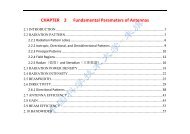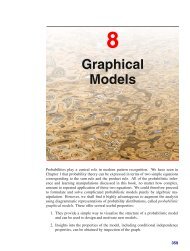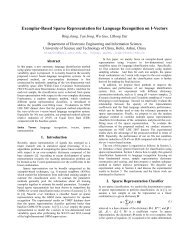CHAPTER10 Traveling Wave and Broadband Antennas
CHAPTER10 Traveling Wave and Broadband Antennas
CHAPTER10 Traveling Wave and Broadband Antennas
You also want an ePaper? Increase the reach of your titles
YUMPU automatically turns print PDFs into web optimized ePapers that Google loves.
<strong>CHAPTER10</strong><br />
<strong>Traveling</strong> <strong>Wave</strong> <strong>and</strong> Broadb<strong>and</strong> <strong>Antennas</strong><br />
目 录<br />
10.1 INTRODUCTION .................................................................................................................................................................................................................................... 2<br />
10.2 TRAVELING WAVE ANTENNAS ............................................................................................................................................................................................................. 3<br />
10.2.1 Long Wire ................................................................................................................................................................................................................................ 12<br />
10.2.2 V Antenna ............................................................................................................................................................................................................................... 29<br />
10.2.3 Rhombic Antenna ................................................................................................................................................................................................................... 37<br />
10.3 BROADBAND ANTENNAS ................................................................................................................................................................................................................... 40<br />
10.3.1 Helical Antenna ....................................................................................................................................................................................................................... 40<br />
10.3.3 Yagi‐Uda Array of Linear Elements ......................................................................................................................................................................................... 66<br />
PROBLEMS ................................................................................................................................................................................................................................................. 81
10.1 INTRODUCTION<br />
In the previous chapters we have presented the details of classical methods<br />
that are used to analyze the radiation characteristics of some of the simplest <strong>and</strong><br />
most common forms of antennas (i.e., infinitely thin linear <strong>and</strong> circular wires,<br />
broadb<strong>and</strong> dipoles, <strong>and</strong> arrays). In practice there is a myriad of antenna<br />
configurations, <strong>and</strong> it would be almost impossible to consider all of them in this<br />
book. The general performance behavior of some of them will be presented in this<br />
chapter with a minimum of analytical formulations.
10.2 TRAVELING WAVE ANTENNAS<br />
In Chapter 4, center‐fed linear wire antennas were discussed whose<br />
amplitude current distribution was<br />
1. constant for infinitesimal dipoles ( λ/50)<br />
2. linear (triangular) for short dipoles (/50 λ/10)<br />
3. sinusoidal for long dipoles ( λ/10)<br />
In all cases the phase distribution was assumed to be constant.<br />
The sinusoidal current distribution of long open‐ended linear antennas is a<br />
st<strong>and</strong>ing wave constructed by two waves of equal amplitude <strong>and</strong> 180 o phase<br />
difference at the open end traveling in opposite directions along its length.
The current <strong>and</strong> voltage distributions on open‐ended wire antennas are<br />
similar to the st<strong>and</strong>ing wave patterns on open‐ended transmission lines.<br />
Linear antennas that exhibit current <strong>and</strong> voltage st<strong>and</strong>ing wave<br />
patterns formed by reflections from the open end of the wire are<br />
referred to as st<strong>and</strong>ing wave or resonant antennas.<br />
<strong>Antennas</strong> can be designed which have traveling wave (uniform) patterns in<br />
current <strong>and</strong> voltage. This can be achieved by properly terminating the antenna<br />
wire so that the reflections are minimized if not completely eliminated.<br />
An example of such an antenna is a long wire that runs horizontal to the<br />
earth, as shown in Figure 10.1.
Figure 10.11 Beverage (long‐wire)) antenna above ground<br />
The<br />
input terminals consist of<br />
the ground <strong>and</strong><br />
one end<br />
of the wire. This<br />
configuration is known as Beverage<br />
( 贝 威 尔 基 天 线 )<br />
or wave<br />
antenna.<br />
There are<br />
many other configurations of traveling wave antennas<br />
.
In general, all antennas whose current <strong>and</strong> voltage distributions can<br />
be represented by one or more traveling waves, usually in the same<br />
direction, are referred to as traveling wave or nonresonant antennas. A<br />
progressive phase pattern is usually associated with the current <strong>and</strong><br />
voltage distributions.<br />
St<strong>and</strong>ing wave antennas, such as the dipole, can be analyzed as traveling<br />
wave antennas with waves propagating in opposite directions <strong>and</strong> represented<br />
by traveling wave currents <strong>and</strong> in Figure 10.1(a).
Besides the long wire antenna there are many examples of traveling wave<br />
antennas such as dielectric rod, helix, <strong>and</strong> various surface wave antennas.<br />
Aperture antennas, such as reflectors <strong>and</strong> horns, can also be treated as traveling<br />
wave antennas. In addition, arrays of closely spaced radiators (usually less than<br />
/2 apart) can also be analyzed as traveling wave antennas by approximating<br />
their current or field distribution by a continuous traveling wave. Yagi‐Uda,<br />
log‐periodic, <strong>and</strong> slots <strong>and</strong> holes in a waveguide are some examples of<br />
discrete‐element traveling wave antennas.
In general, a traveling wave antenna is usually one that is associated with<br />
radiation from a continuous source.<br />
A traveling wave may be classified as a slow wave if its phase velocity<br />
( /k, ω: wave angular frequency, k = wave phase constant) is equal or<br />
smaller than the velocity of light c in free‐space ( /c 1).<br />
A fast wave is one whose phase velocity is greater than the speed of light<br />
( /c 1).<br />
In general, there are two types of traveling wave antennas.
1. Surface wave antenna<br />
One is the surface wave antenna defined as “an antenna whichh radiates<br />
power flow from discontinuities in the structure that interrupt a bound<br />
wave on<br />
the antenna surface.”A surface wave<br />
antennaa is, in general, a slow wave<br />
structure<br />
whose phase velocity of the traveling wave is equal to or lesss than the<br />
speed of<br />
light in free‐space<br />
( <br />
c 1).<br />
For slow wave structures radiation takes place only at nonuniformities,<br />
curvatures, <strong>and</strong> discontinuities. Discontinuities can be either discrete or<br />
distributed.
• One type of discrete discontinuity on a surface<br />
wave antenna is a transmission line terminated in an<br />
unmatched load.<br />
• A distributed surface wave antenna can be<br />
analyzed in terms of the variation of the amplitude <strong>and</strong><br />
phase of the current along its structure.<br />
In general, power flows parallel to the<br />
structure,<br />
except when losses are present, <strong>and</strong> for plane<br />
structures<br />
the fields<br />
decay exponentially away<br />
from the antenna.<br />
Most of the surface wave antennas are end‐fire or<br />
near‐end‐firline, planar surface, curved,<br />
<strong>and</strong> modulated structures.<br />
radiators. Practical configurations include
2. Leaky‐wave antenna<br />
Another traveling wave antenna is a leaky‐wavl<br />
ve antenna defined as “an<br />
antenna that couples power in small increments<br />
per unit length, either<br />
continuously or discretely, from a traveling wave<br />
structure to free‐space”<br />
Leaky‐wave antennas continuously<br />
lose energy due to radiation, as shown in<br />
Figure 10.2 by a slotted rectangular waveguide. The fields<br />
decay along the<br />
structure in the direction of<br />
wave travel <strong>and</strong> increase i<br />
in others.<br />
Figure 10.2 Leaky‐wave waveguidee slots; upper (broad) <strong>and</strong> side (narrow) walls.
10.2.1 Long Wire<br />
An antenna is usually<br />
classified as a long wire<br />
antennaa if it is<br />
conductor<br />
with a length from one to many wavelengths.<br />
a straight<br />
The<br />
analyzed<br />
presence<br />
using the<br />
long wire of Figure 10.1(a), in the presence of the ground, can be<br />
approximately by introducing an<br />
image to take into account the<br />
of the ground. The magnitude <strong>and</strong> phase of<br />
the image are determined<br />
reflection<br />
coefficient for horizontal<br />
polarization as given by
1 , (4‐129)<br />
<br />
<br />
<br />
<br />
<br />
<br />
∥ <br />
<br />
for 0 , 180 plane<br />
for 90 ,270 plane<br />
• ∥ , : the reflection coefficients for parallel <strong>and</strong> perpendicular polarization<br />
The angles <strong>and</strong> are angles of incidence <strong>and</strong> refraction, respectively. <br />
<strong>and</strong> are intrinsic impedance of free‐space <strong>and</strong> the ground, respectively.<br />
The height of the antenna above the ground must be chosen so that the<br />
reflected wave is in phase with the direct wave at the angles of desired maximum<br />
radiation. The total field can be found by multiplying the field radiated by the<br />
wire in free space by the array factor of a two‐element array.
As the wave<br />
travels along the wire from the<br />
source toward the<br />
load, it continuously leaks<br />
energy.<br />
This<br />
can be<br />
represented by an attenuationn<br />
coefficient. Therefore the current distribution of the<br />
forward traveling<br />
wave along the<br />
structure can be<br />
represented by<br />
Figure 10.3 Long‐wire antennaa<br />
z′ <br />
0 <br />
<br />
(10‐1)<br />
• z′ z′ z′: the propagation coefficient.<br />
• The attenuationn factor z′ can also represent the ohmic losses of the wire as well<br />
as ground losses, which are very small <strong>and</strong> are<br />
neglected.<br />
• When the radiating medium is air, the loss of energy in a long wire due to<br />
leakage is<br />
very small, <strong>and</strong> it can also be neglected.
Therefore the current distribution of (10‐1) can be approximated by<br />
z′ <br />
(10‐1)<br />
⇒ ′ 0 <br />
(10‐1a)<br />
where z′ is assumed to be constant. In the far field<br />
0 (10‐2a); <br />
<br />
0 <br />
<br />
2 <br />
<br />
sin <br />
<br />
<br />
10‐2c<br />
10‐2b<br />
is used to represent the ratio of the phase constant of the wave along the<br />
transmission line ( ) to that of free‐space (), or<br />
<br />
<br />
<br />
wavelength along the transmission line (10‐3)
Assuming a perfect electric conductor for the ground, the total field for<br />
Figure 10.1(a) is obtained by multiplying each of (10‐2a)–(10‐2c) by the array<br />
factor sinsin.<br />
For kK1 the time‐average power density can be written as<br />
| | <br />
<br />
⇒ | | <br />
<br />
<br />
1 (10‐4)<br />
<br />
<br />
1 (10‐5)<br />
From (10‐5) it is evident that the power distribution of a wire antenna of<br />
length is a multilobe pattern whose number of lobes depends upon its length.
Assuming that is very large such that the variations in the sine function of<br />
(10‐5) are more rapid than those of the cotangent, the peaks of the lobes occur<br />
approximately when<br />
sin <br />
cos 1 1; cos m<br />
<br />
1 21<br />
π, m 0,1,2, …(10‐6)<br />
2<br />
The angles where the peaks occur are given by<br />
cos 1 21, 0,1,2,… (10‐7)<br />
The angle where the maximum of the major lobe occurs is given by m = 0.
As becomes very large ( ≫ ), the angle of the maximum of the<br />
major lobe approaches zero degrees <strong>and</strong> the structure becomes a<br />
near‐end‐fire array.<br />
In finding the values of the maxima, the variations of the cotangent term in<br />
(10‐5) were negligible. If the effects of the cotangent term were to be included,<br />
the values of the 2m 1 term in (10‐7) should be<br />
2 1 0.742,2.93,4.96,6.97,8.99,11,13,... (10‐8)<br />
In a similar manner, the nulls of the pattern can be found <strong>and</strong> occur when<br />
sin <br />
cos 1 n<br />
0 , <br />
cos 1 ,1,2,3,… (10‐9)<br />
The angles where the nulls occur are given by
1 , 1,2,3,4 … 10‐10<br />
The total radiated power can be found by integrating (10‐5) over a closed<br />
sphere of radius <strong>and</strong> reduces to<br />
∯<br />
<br />
∙<br />
<br />
| | 1.415 <br />
2 <br />
<br />
<br />
10‐11<br />
where is the cosine integral of (4‐68a). The radiation resistance is then<br />
found to be<br />
<br />
<br />
1.415 <br />
| | <br />
2 <br />
Using (10‐5) <strong>and</strong> (10‐11) the directivity can be written as<br />
<br />
<br />
(10‐12)<br />
<br />
. <br />
<br />
. <br />
<br />
<br />
(10‐13)
A. Amplitude Patterns, Maxima, <strong>and</strong> Nulls<br />
• Fig 10.4(a): the<br />
• Fig 10.4(b): the<br />
3‐D pattern of a traveling wire antenna with<br />
3‐D pattern of a st<strong>and</strong>ing wave wire<br />
antenna<br />
5<br />
with 5.<br />
• The corresponding 2‐D patterns are shown<br />
in Figure<br />
10.5.<br />
0<br />
120<br />
90<br />
60<br />
-10<br />
-20<br />
150<br />
30<br />
-30<br />
-40<br />
-30<br />
180<br />
0<br />
-20<br />
-10<br />
210<br />
330<br />
0<br />
240<br />
270<br />
300<br />
Figure 10.4<br />
Three‐dimensional<br />
free‐spacee amplitude<br />
patterns for traveling <strong>and</strong> st<strong>and</strong>ing wave<br />
wire antennas of
The pattern formed by<br />
the forward<br />
traveling<br />
wave current <br />
<br />
has<br />
maximumm<br />
radiation<br />
in<br />
the<br />
forward<br />
direction<br />
The<br />
pattern<br />
formed<br />
by<br />
st<strong>and</strong>ing<br />
<br />
<br />
2 . when <br />
There<br />
is maximum radiation in the forward <strong>and</strong><br />
backward<br />
directions.<br />
Figure 10.5 Two‐dimensional free‐space<br />
amplitude pattern for traveling <strong>and</strong> st<strong>and</strong>ing<br />
wave wire antennas of 5<br />
The lobe near<br />
the axis<br />
of the wire in the<br />
directions of travel is the largest.
• The traveling wave antenna is used<br />
when<br />
it is desired to<br />
radiate<br />
or<br />
receivee predominantly<br />
from one<br />
direction.<br />
• As the<br />
length of<br />
the wire increases,<br />
the maximum of<br />
the main<br />
lobe shifts<br />
closer<br />
toward<br />
the axis <strong>and</strong> the<br />
number of lobes<br />
increase.<br />
Figure 10.6 Fr<br />
wave wire antenna ree‐space of pattern for<br />
<strong>and</strong> traveling
The angles of<br />
the maxima of the first four lobes, computed using ( 10‐8), are<br />
plotted in<br />
Figure 10.7(a) for 0.5 10. The corresponding angles of the<br />
first four<br />
nulls, computed<br />
using (10‐10), are shown in Figure 10.7(b) for<br />
0.5 10. These curves can be used effectively<br />
to design long wires when<br />
the direction of the<br />
maximum or null is desired.<br />
Figure 10.7 Angles versus length of<br />
wire antenna wheree maxima <strong>and</strong> nulls occur
B. Input<br />
Impedance<br />
For traveling<br />
wave wire antennas the radiation<br />
in the opposite direction<br />
from the maximumm is suppressed by<br />
reducing the current reflected from<br />
the end<br />
of the wire. This is accomplished by<br />
• Increasing<br />
the diameter of the wire<br />
• Or<br />
terminating it to the ground, as shown in Figure 10.1.<br />
Ideally a complete eliminationn of the<br />
reflections (perfect match) can only be<br />
accomplished if the antenna is elevated<br />
only at small heights (compared<br />
to the<br />
wavelength) above the ground, <strong>and</strong> it is<br />
terminated by a resistive load.
The value of the load resistor is equal to the characteristic impedance of the<br />
wire near the ground (which is found using image theory). For a wire with<br />
diameter <strong>and</strong> height above the ground, an approximate value of the<br />
termination resistance is obtained from<br />
138log (10‐14)<br />
If the antenna is not properly terminated, st<strong>and</strong>ing wave pattern would be<br />
created. Therefore the input impedance of the line is not equal to the load<br />
impedance. The transmission line impedance transfer equation can be used to<br />
calculate the impedance at the input terminals<br />
<br />
(10‐15)
C. Polarization<br />
A long‐wire antenna is linearly polarized, <strong>and</strong> it is always parallel to the<br />
plane formed by the wire <strong>and</strong> radial vector from the center of the wire to the<br />
observation point.<br />
The direction of the linear polarization is not the same in all parts of the<br />
pattern, but it is perpendicular to the radial vector (<strong>and</strong> parallel to the plane<br />
formed by it <strong>and</strong> the wire). Thus the wire antenna is not an effective element for<br />
horizontal polarization. Instead it is usually used to transmit or receive waves<br />
that have an appreciable vector component in the vertical plane. This is what is<br />
known as a Beverage antenna which is used more as a receiving rather than a<br />
transmitting element because of its poor radiation efficiency due to power<br />
absorbed in the load resistor.
D. Resonant Wires<br />
Resonant wire antennas are formed when the load impedance of Figure<br />
10.1(a) is not matched to the characteristic impedance of the line. This causes<br />
reflections which with the incident wave form a st<strong>and</strong>ing wave. Resonant<br />
antennas, including the dipole, were examined in Chapter 4.<br />
Resonant antennas can also be formed by long wires. For resonant long<br />
wires with lengths odd multiple of half wavelength ( /2, n = 1, 3, . . .), the<br />
radiation resistance is given approximately (within 0.5 ohms)by<br />
73 69 log (10‐16)<br />
For the same elements, the angle of maximum radiation is given by<br />
<br />
(10‐17)
This formula is more accurate for small values of , although it gives good<br />
results even for large values of . It can also be shown that the maximum<br />
directivity is related to the radiation resistance by<br />
<br />
<br />
<br />
(10‐18)
10.2.2 V Antenna<br />
For some applications<br />
a single long‐wire<br />
antenna is not practical because<br />
(1) its directivity may<br />
be low<br />
(2) its side lobes may be high<br />
(3) its main beam is nclined at<br />
an angle, which is<br />
controlled by its length.<br />
One very practical array of long wires is<br />
the V antenna formed by<br />
using two wires<br />
each with<br />
one of its ends connected<br />
to a feed<br />
line as shown in Figure 10. .8(a).<br />
In most applications,<br />
the plane formed<br />
by the legs of the V is parallel to the ground,<br />
whose principal polarization is parallel to<br />
the ground <strong>and</strong> the plane of the V.
Because of increased<br />
side lobes, the directivity<br />
of ordinary linear dipoles<br />
begins to<br />
diminish<br />
for lengths greater than about 1.25. However by adjusting the<br />
included angle of a V‐dipole, its directivity can be made greaterr <strong>and</strong> its<br />
side lobes<br />
smaller than those<br />
of a corresponding linear dipole.<br />
Designs for maximum<br />
directivity usually<br />
require<br />
smaller included<br />
angles for<br />
longer V’s. Most V<br />
antennas<br />
are symmetrical<br />
(θ θ <br />
θ <strong>and</strong><br />
<br />
). Also<br />
V antennas can be designed to have unidirectional<br />
or bidirectional<br />
radiation<br />
patterns,<br />
as shown<br />
in Figures 10.8(b) <strong>and</strong> (c),, respectively.
To achieve the unidirectional<br />
characteristics, the wires<br />
must be nonresonant. The reflected waves can be reduced by<br />
of the V antennaa<br />
Make the inclined wires of the V relatively thick<br />
Properly terminate the open ends off the V<br />
One way to terminate the V antennaa is to<br />
attach a load, usually a resistor equal in value<br />
to the<br />
open end<br />
characteristic impedancee of the V‐wire<br />
transmission line, as shown<br />
in Figure<br />
10.9(a). .<br />
The terminating resistance can also be divided<br />
in half <strong>and</strong> each half connected<br />
to the ground<br />
leading to<br />
the termination of Figure 10.9(b).<br />
Figure 10.9 Terminated V<br />
antennas.
• If the length of each leg of the V is very long ( typically 5), there will<br />
be sufficient leakage of the field along each leg that when the wave reaches the<br />
end of the V it will be sufficiently reduced that there will not necessarily be a need<br />
for a termination.<br />
The patterns of the individual wires of the V antenna are conical <strong>and</strong> inclined<br />
at an angle from their corresponding axes. The angle of inclination is determined<br />
by the length of each wire.<br />
The patterns of each leg of a symmetrical V antenna will add in the direction<br />
of the line bisecting the angle of the V <strong>and</strong> form one major lobe, the total included<br />
angle 2 of the V should be equal to 2 , which is twice the angle that the cone<br />
of maximum radiation of each wire makes with its axis. When this is done, beams<br />
2 <strong>and</strong> 3 of Figure 10.8(b) are aligned <strong>and</strong> add constructively.
Similarly for<br />
Figure 10.8(c),<br />
beams 2 <strong>and</strong> 3 are aligned <strong>and</strong> addd<br />
constructively in the forward direction, while<br />
beams 5 <strong>and</strong> 8 are aligned <strong>and</strong> addd<br />
constructively in the backward direction.<br />
• If<br />
2θ 2θ the<br />
main lobe is split<br />
into two<br />
distinct beams.<br />
• If (2θ 2θ ), the maximum of the single major lobe is still along the<br />
plane that bisects the V but<br />
it is tilted upward from the plane of the V due to the<br />
existence of GND.
For a symmetrical V antenna with legs each of length , there is an optimum<br />
included angle which leads to the largest directivity. The polynomials for<br />
optimum included angles <strong>and</strong> maximum directivities are given by<br />
2θ <br />
149/ 603.4/ 809.5/ 443.6 10 19a<br />
0.5 / 1.5<br />
13.39/ 78.27/ 169.77 10 19b<br />
<br />
1.5 / 3<br />
D 2.94/ 1.15, 1.5/3 (10‐20)<br />
The corresponding input impedances of the V’s are slightly smaller than<br />
those of straight dipoles.
Another form<br />
of a V antenna is<br />
shown in<br />
Figure 10.11(a). The V is formed by<br />
a monopole wire,<br />
bent at an angle over a ground plane, <strong>and</strong> by its image shown<br />
dashed. The included angle<br />
as well as the length can be<br />
used to<br />
tune the<br />
antenna.<br />
• For 2θ<br />
120 , the antenna exhibits<br />
primarily<br />
vertical<br />
polarization<br />
with<br />
radiation<br />
patterns almost identical to<br />
those of straight dipoles.<br />
• As 2θ 120 , a horizontally polarized<br />
field component is<br />
excited which tends to<br />
fill the<br />
pattern<br />
toward<br />
the horizontal<br />
direction,<br />
making<br />
it a very attractive<br />
communication antenna for<br />
aircraft.
The<br />
computed impedance of the<br />
ground<br />
plane <strong>and</strong> free‐space V<br />
configurations obtained by<br />
the MoM<br />
is shown<br />
plotted in Figure<br />
10.11(a) .<br />
Another practical form<br />
of a dipole antenna, particularly useful for airplane or<br />
ground plane applications,<br />
is the 90<br />
bent wire configuration<br />
of Figure<br />
10.11(b) ).<br />
The computed impedance of the antenna is shown plotted in Figure 10.11(b).<br />
This<br />
antennaa can be tuned<br />
by<br />
adjusting<br />
its perpendicular<br />
<strong>and</strong> parallel<br />
lengths<br />
<strong>and</strong><br />
<br />
.The<br />
radiation<br />
pattern in<br />
the plane of the antenna is<br />
nearly omnidirectional for h 0.1λ .<br />
For h <br />
0.1 the<br />
pattern<br />
approaches<br />
that of vertical λ/2<br />
dipole.
10.2.3 Rhombic Antenna<br />
A. Geometry <strong>and</strong><br />
Radiation Characteristicss<br />
Two V antennas can be connected at their open ends to form a diamond or<br />
rhombic antenna, as shown<br />
in Figure 10.12( (a). To achieve the<br />
single main lobe,<br />
beams 2, 3, 6, <strong>and</strong> 7 are aligned <strong>and</strong><br />
add constructively. The other end is used to<br />
feed the antenna.
• The antenna is usually terminated<br />
at one end in a resistor of<br />
600–8000 ohms, in<br />
order to reduce if not eliminate reflections.<br />
.<br />
• If each leg is long enough<br />
(>5λ) sufficient leakage occurs along each leg that the<br />
wave that reaches the far<br />
end of the rhombus is sufficiently reduced that it may<br />
not be necessary<br />
to terminate the rhombus.<br />
Another configuration<br />
of a rhombus is that of<br />
Figure<br />
formed by<br />
an inverted V <strong>and</strong> its image (shown<br />
dashed) ).<br />
10.12(b)<br />
which is
The inverted V is connected to the ground through a resistor. As with the “V”<br />
antennas, the pattern of rhombic antennas can be controlled by varying the<br />
element lengths, angles between elements, <strong>and</strong> the plane of the rhombus.<br />
Rhombic antennas are usually preferred over V’s for nonresonant <strong>and</strong><br />
unidirectional pattern applications because they are less difficult to terminate.<br />
Additional directivity <strong>and</strong> reduction in side lobes can be obtained by<br />
stacking, vertically or horizontally, a number of rhombic <strong>and</strong>/or V antennas to<br />
form arrays.
10.3 BROADBAND ANTENNAS<br />
In Chapter 9 broadb<strong>and</strong> dipole antennas were discussed. There are<br />
numerous other antenna designs that exhibit greater broadb<strong>and</strong> characteristics<br />
than those of the dipoles. Some of these antennas can also provide circular<br />
polarization, a desired extra feature for many applications.<br />
10.3.1 Helical Antenna<br />
Another basic, simple, <strong>and</strong> practical configuration of an electromagnetic<br />
radiator is that of a conducting wire wound in the form of a screw thread forming<br />
a helix.<br />
In most cases the helix is used with a ground plane. The ground plane can<br />
take different forms.
• One is for the ground to be flat, as shown<br />
in Figure<br />
10.13. Typicallyy the diameter of the<br />
ground plane should be at least 3/ /4.<br />
• The ground plane can also be cupped in<br />
the form of a cylindrical cavity or in<br />
the form<br />
of<br />
a frustrum cavity.<br />
The helix is usually connected<br />
to the<br />
center conductor<br />
of a coaxial transmission<br />
line at the feed<br />
point with the<br />
outer<br />
conductor of the<br />
line attached to the<br />
ground plane.
The geometrical configuration of a helix consists usually of<br />
• : turns,<br />
• : diameter<br />
• : The total length of the antenna<br />
• : the total length of the wire<br />
• : space between each turn. √ , √ <br />
is the circumference of the helix.<br />
• Another important parameter is the pitch angle <br />
<br />
(10‐24)<br />
The radiation characteristics of the antenna can be varied by controlling the<br />
size of its geometrical properties compared to the wavelength.<br />
The input impedance is critically dependent upon <strong>and</strong> the size of the<br />
conducting wire, <strong>and</strong> it can be adjusted by controlling their values.
The general polarization<br />
of the antenna is elliptical. However circular <strong>and</strong><br />
linear polarizations can be achieved over different frequency<br />
ranges.<br />
The helical antenna can operate in many modes;<br />
however<br />
the two<br />
principal<br />
ones are the normal (broadside) <strong>and</strong><br />
the axiall (end‐fire) modes.<br />
Figure 10.14 Three‐dimensional<br />
normalized amplitude linear power<br />
patterns for normal <strong>and</strong><br />
end‐fire<br />
modes helical designs.
Figure 10.14(a), representing the normal mode, has its maximum in a<br />
plane normal to the axis <strong>and</strong> is nearly null along the axis. The pattern is similar in<br />
shape to that of a small dipole or circular loop.<br />
Figure 10.14(b), representative of the axial mode, has its maximum along<br />
the axis of the helix, <strong>and</strong> it is similar to that of an end‐fire array. The axial<br />
(end‐fire) mode is usually the most practical because it can achieve circular<br />
polarization over a wider b<strong>and</strong>width (usually 2:1) <strong>and</strong> it is more efficient.<br />
A helix can always receive a signal transmitted from a rotating linearly<br />
polarized antenna. Therefore helices are usually positioned on the ground for<br />
space telemetry applications of satellites, space probes, <strong>and</strong> ballistic missiles to<br />
transmit or receive signals.
A. Normal Mode<br />
To achieve the normal mode of operation, the dimensions of the helix are<br />
usually small compared to the wavelength (i.e., ≪ ). The helix reduces<br />
to a loop of diameter when the pitch angle ⟹ 0 <br />
to a linear wire of length when ⟹90 .<br />
Since the limiting geometries of the helix are a loop <strong>and</strong> a dipole, the far field<br />
radiated by a small helix in the normal mode can be described in terms of <strong>and</strong><br />
components of the dipole <strong>and</strong> loop, respectively.<br />
In the normal mode, the helix of Figure 10.15(a) can be simulated<br />
approximately by small loops <strong>and</strong> short dipoles connected together in<br />
series as shown in Figure 10.15(b). The fields are obtained by superposition of<br />
the fields from these elemental radiators.
Since<br />
in the normal<br />
dimensions are small,<br />
• the current throughout<br />
assumed to be constant<br />
mode the helix<br />
its length<br />
can be<br />
• its relative<br />
far‐field pattern to be<br />
independent of the number of loops <strong>and</strong><br />
short dipoles.<br />
Figure 10.15 Normal (broadside) mode for<br />
helical antenna <strong>and</strong> its equivalent.<br />
Thus<br />
its operation can<br />
be described by<br />
the sum<br />
of the fields radiated by a<br />
small loop<br />
of radius <strong>and</strong><br />
a short dipole of length ,<br />
with its axis perpendicular<br />
to the plane of the loop, <strong>and</strong><br />
each with the same constant current distribution.
The far‐zone electric field radiated by a short dipole of length <strong>and</strong><br />
constant current is<br />
<br />
(4‐26a/10‐25)<br />
<br />
The electric field radiated by a loop is<br />
/ <br />
<br />
(10-26)<br />
A comparison of (10‐25) <strong>and</strong> (10‐26) indicates that the two components are in<br />
time‐phase quadrature, a necessary but not sufficient condition for circular or<br />
elliptical polarization.<br />
The ratio of the magnitudes of the <strong>and</strong> components is defined as the<br />
axial ratio (AR), <strong>and</strong> it is given by
| |<br />
| | <br />
(10‐27)<br />
By varying the <strong>and</strong>/or the axial ratio attains values of 0 AR ∞.<br />
• AR = 0 occurs when 0 leading to a linearly polarized wave of horizontal<br />
polarization (the helix is a loop).<br />
• AR ∞, 0 <strong>and</strong> the radiated wave is linearly polarized with vertical<br />
polarization (the helix is a vertical dipole).<br />
• AR = 1, the radiated field is circularly polarized in all directions other than<br />
θ0 where the fields vanish.<br />
2 , / /2 <br />
To achieve the normal mode of operation, it has been assumed that the<br />
current throughout the length of the helix is of constant magnitude <strong>and</strong> phase.
This is satisfied to a large extent provided<br />
• The total length of the helix wire is very small compared to the<br />
wavelength ( ≪ )<br />
• Its end is terminated properly to reduce multiple reflections.<br />
Because of the critical dependence of its radiation characteristics on its<br />
geometrical dimensions, which must be very small compared to the wavelength,<br />
this mode of operation is very narrow in b<strong>and</strong>width <strong>and</strong> its radiation efficiency is<br />
very small. Practically this mode of operation is limited, <strong>and</strong> it is seldom utilized.
B. Axial Mode<br />
A more practical mode of operation, which can be generated with great ease,<br />
is the axial or end‐fire mode. In this mode of operation,<br />
• There is only one major lobe <strong>and</strong> its maximum radiation intensity is along<br />
the axis of the helix.<br />
• The minor lobes are at oblique angles to the axis.<br />
To excite this mode, the diameter <strong>and</strong> spacing must be large fractions<br />
of the wavelength. To achieve circular polarization, primarily in the major lobe,<br />
the circumference of the helix must be in the range (with / <br />
= 1<br />
near optimum), <strong>and</strong> the spacing about S /4. The pitch angle is usually<br />
12 α14 .
Most often the antenna is used in conjunction with a ground plane, whose<br />
diameter is at least /2, <strong>and</strong> it is fed by a coaxial line. However, other types of<br />
feeds (such as waveguides <strong>and</strong> dielectric rods) are possible, especially at<br />
microwave frequencies.<br />
The dimensions of the helix for this mode of operation are not as<br />
critical, thus resulting in a greater b<strong>and</strong>width.
C. Design Procedure<br />
The terminal impedance of a helix radiating in the axial mode is nearly<br />
resistive with values between 100 <strong>and</strong> 200 ohms. Smaller values, even near 50<br />
ohms, can be obtained by properly designing the feed. Empirical expressions,<br />
based on a large number of measurements, have been derived. The input<br />
impedance (purely resistive) is obtained by<br />
140 (10‐30)<br />
<br />
which is accurate to about ±20%, the half‐power beamwidth by<br />
the beamwidth between nulls by<br />
HPBWdegree ∙ /<br />
<br />
√<br />
(10‐31)
FNBWdegree ∙ /<br />
<br />
√<br />
(10‐32)<br />
dimensionless 15 <br />
<br />
(10‐33)<br />
the axial ratio (for the condition of increased directivity) by<br />
<strong>and</strong> the normalized far‐field pattern by<br />
<br />
<br />
(10‐34)<br />
/<br />
<br />
/<br />
10‐35<br />
cos / (10‐35a)<br />
/ <br />
<br />
For ordinary end‐fire radiation (10‐35b)<br />
<br />
/ <br />
<br />
<br />
For Hansen‐Woodyard end‐fire radiation (10‐35c)
All these relations are approximately valid provided 12 α14 , 3/4 <br />
/ 4/3 <strong>and</strong> N >3.<br />
The far‐field pattern of the helix, as given by (10‐35), has been developed by<br />
assuming that the helix consists of an array of identical turns, a uniform<br />
spacing between them, <strong>and</strong> the elements are placed along the z‐axis.<br />
The cos term in (10‐35) represents the field pattern of a single turn,<br />
The last term<br />
elements.<br />
/<br />
/<br />
in (10‐35) is the array factor of a uniform array of <br />
The total field is obtained by multiplying the field from one turn with the array<br />
factor.
The value of p is the ratio of the velocity with which the wave travels along<br />
the helix wire, <strong>and</strong> it is selected according to (10‐35b) for ordinary end‐fire<br />
radiation or (10‐35c) for Hansen‐Woodyard end‐fire radiation.<br />
(1) For ordinary end‐fire<br />
The relative phase among the various turns of the helix (elements of the<br />
array) is given by (6‐7a), or<br />
(10‐36)<br />
where is the spacing between the turns.<br />
For an end‐fire design, the radiation from each one of the turns along θ 0 <br />
must be in phase. Since the wave along the helix wire between turns travels a<br />
distance 0 with a wave velocity 0 (
for ordinary end‐fire radiation is equal to<br />
cos <br />
<br />
2, 0,1,2, … (10‐37)<br />
Solving (10‐37) for leads to<br />
/ <br />
<br />
(10‐38)<br />
For 0 <strong>and</strong> 1, 0 √ . This corresponds to a straight<br />
wire (α 90 ), <strong>and</strong> not a helix. Therefore the next value is 1, <strong>and</strong> it<br />
corresponds to the first transmission mode for a helix. Substituting 1 in<br />
(10‐38) leads to<br />
/ <br />
<br />
<br />
(10‐38a)
(2) for Hansen‐Woodyard end‐fire radiation<br />
In a similar manner, it can be shown that for Hansen‐Woodyard end‐fire<br />
radiation (10‐37) is equal to<br />
cos <br />
<br />
2 , 0,1,2, … (10‐39)<br />
which when solved for leads to<br />
<br />
/ <br />
<br />
<br />
<br />
<br />
<br />
/ <br />
<br />
(10‐40)
Example 10.1<br />
Design a 10‐turn helix to operate in the axial mode. For an optimum design,<br />
1. Determine the:<br />
a. Circumference (in ), pitch angle (in degrees), <strong>and</strong> separation between turns (in )<br />
b. Relative (to free space) wave velocity along the wire of the helix for:<br />
i. Ordinary end‐fire design<br />
ii. Hansen‐Woodyard end‐fire design<br />
c. Half‐power beamwidth of the mainlobe (in degrees)<br />
d. Directivity (in dB) using:<br />
i. A formula
ii. The computer program Directivity of Chapter 2<br />
e. Axial ratio (dimensionless <strong>and</strong> in dB)<br />
2. Plot the normalized three‐dimensional linear power pattern for the ordinary <strong>and</strong><br />
Hansen‐Woodyard designs.<br />
Solution:<br />
1. a. For an optimum design<br />
Condition: 12 α14 , 3/4 / 4/3 <strong>and</strong> N >3<br />
⟹ , α13 ⟹SCtanα tan13 0.231 <br />
b. The length of a single turn is<br />
1.0263 <br />
Therefore the relative wave velocity is:<br />
i. Ordinary end‐fire:
ii.<br />
<br />
Hansen‐Woodyard end‐fire:<br />
/ <br />
/ 1 1.0263<br />
0.231 1 0.8337<br />
<br />
/ <br />
.<br />
. <br />
<br />
<br />
<br />
c. The half‐power beamwidth according to (10‐31) is<br />
=0.8012<br />
HPBWdegree 52 ∙ /<br />
<br />
√ 52<br />
√10 ∙ 0.231 34.21o<br />
d. The directivity is:<br />
i. Using (10‐33):<br />
dimensionless 15 <br />
<br />
<br />
e. The axial ratio according to (10‐34) is:<br />
15 ∙ 10 ∙ 0.231 34.65 15.397 <br />
AR 2N 1/2N 21/20 1.05 dimensionless 0.21 dB
2. The three‐dimensional linear power patterns for the two<br />
Hansen‐Woodyard, are shown in Figure 10.16<br />
end‐fire designs, ordinary <strong>and</strong><br />
Figure 10.16 Three‐dimensional<br />
normalized amplitude linear power<br />
patterns for<br />
helical ordinary (p =<br />
0.8337) <strong>and</strong> Hansen‐Woodyard (p = 0.8012) end‐fire designs
D. Feed Design<br />
The nominal impedance of a helical antenna operating in the axial mode,<br />
computed using (10‐30)<br />
140/ <br />
is 100~200. However, many practical transmission lines have characteristic<br />
impedance of about 50. The input impedance of the helix must be reduced to<br />
near that value. There may be a number of ways by which this can be<br />
accomplished. One way to properly design the first 1/4 turn of the helix which is<br />
next to the feed.<br />
To bring the input impedance of the helix from nearly 150 down to 50,
the wire of the first 1/4 turn<br />
should<br />
be flat in<br />
the form<br />
of a strip<br />
<strong>and</strong> the<br />
transitionn<br />
into a helix should<br />
be very gradual.<br />
留 出 螺 旋 最 底 部 的 1/4 圈 , 制 成 平 行 于 接 地 面 的 锥 削 过 渡 段 , 将 140~<br />
150 的 螺 旋 阻 抗 变 换 为 50 的 同 轴 线 阻 抗 。 其 结 构 细 节 如 图 所 示<br />
This<br />
is accomplished by making the wire from the feed, at the beginning of
the formation of the helix, in the form of a strip of width by flattening it <strong>and</strong><br />
nearly touching the ground plane which is covered with a dielectric slab of height<br />
where<br />
<br />
= width of strip conductor of the helix starting at the feed<br />
= dielectric constant of the dielectric slab covering the ground plane<br />
= characteristic impedance of the input transmission line<br />
<br />
<br />
√ (10‐41)<br />
Typically the strip configuration of the helix transitions from the strip to the<br />
regular circular wire <strong>and</strong> the designed pitch angle of the helix very gradually<br />
within the first 1/4–1/2 turn.
This modification decreases the characteristic impedance of the<br />
conductor‐ground plane effective transmission line, <strong>and</strong> it provides a lower<br />
impedance over a substantial but reduced b<strong>and</strong>width.<br />
• For example, a 50 helix has a VSWR of less than 2:1 over a 40%<br />
b<strong>and</strong>width compared to a 70% b<strong>and</strong>width for a 140 helix.<br />
• In addition, the 50 helix has a VSWR of less than 1.2:1 over a 12%<br />
b<strong>and</strong>width as contrasted to a 20% b<strong>and</strong>width for one of 140 .<br />
A simple <strong>and</strong> effective way of increasing the thickness of the conductor near the<br />
feed point will be to bond a thin metal strip to the helix conductor. For example, a<br />
metal strip 70‐mm wide was used to provide a 50 impedance in a helix whose<br />
conducting wire was 13‐mm in diameter <strong>and</strong> it was operating at 230.77 MHz.
10.3.3 Yagi‐Uda Array of Linear Elements<br />
Another very<br />
practical radiatorr in the HF (3–30 MHz), VHF (30–300 MHz) ),<br />
<strong>and</strong> UHF (300–3,000 MHz) ranges is the Yagi‐Uda antenna.<br />
This antennaa consists of a number of<br />
linear dipole elements, as<br />
shown in Figure<br />
10.19, one of which is energized directly by a<br />
feed transmission<br />
line while the others act as<br />
parasitic radiators<br />
or reflector, whose<br />
currents are induced by mutual coupling.<br />
This radiator<br />
“wave canal.”<br />
is an end‐fire array, Yagi designate<br />
ed the row<br />
of directors as a
To achieve the end‐fire beam<br />
formation,<br />
• The parasitic<br />
elements in the<br />
than the feed element.<br />
direction<br />
of the beam are<br />
smaller<br />
in length<br />
• The driven element is<br />
resonant<br />
with its length l slightly lesss than λ/ /2<br />
• The lengths of the directors should be about 0. 4~0.45λ.<br />
not necessarily of the same length <strong>and</strong>/or diameter.<br />
The directors are
• The separation between the directors is 0.3~0.4, <strong>and</strong> it is not necessarily<br />
uniform.<br />
• The gain was independent of the radii of the directors up to ~0.024.<br />
• The length of the reflector is greater than that of the feed. In addition, the<br />
separation is smaller than the spacing between the driven element <strong>and</strong> the<br />
nearest director, <strong>and</strong> it is ~0.25.<br />
• Since the length of each director is smaller than its corresponding resonant<br />
length, the impedance of each is capacitive <strong>and</strong> its current leads the induced emf.<br />
• Similarly the impedance of the reflector is inductive <strong>and</strong> the phases of the<br />
currents lag those of the induced emfs.<br />
• The phase of the currents in the directors <strong>and</strong> reflectors is not determined<br />
solely by their lengths but also by their spacing to the adjacent elements.
Thus, properly spaced elements with lengths slightly less than their<br />
corresponding resonant lengths (less than /2) act as directors because they<br />
form an array with currents approximately equal in magnitude <strong>and</strong> with equal<br />
progressive phase shifts which will reinforce the field of the energized element<br />
toward the directors.<br />
Similarly, a properly spaced element with a length of /2 or slightly<br />
greater will act as a reflector.<br />
Thus a Yagi‐Uda array may be regarded as a structure supporting a traveling<br />
wave. Higher resonances are available near lengths of , 3/2, <strong>and</strong> so forth, but<br />
are seldom used.
Figure 10.23 Directivity<br />
<strong>and</strong> front‐to‐back ratio, as a<br />
function of reflector spacing, of a 15‐element Yagi‐Uda<br />
array.<br />
Figure 10.24 Directivity <strong>and</strong><br />
front‐to‐back ratio, as a<br />
function of director spacing, for 15‐element<br />
Yagi‐Uda array.
1. The total field represented<br />
<br />
<br />
<br />
<br />
4<br />
∑<br />
10‐65<br />
<br />
<br />
<br />
<br />
<br />
<br />
<br />
2. Input Impedance <strong>and</strong> Matching Techniques<br />
<br />
<br />
<br />
10‐65a<br />
The input impedance of a Yagi‐Uda array, measured at the center of the<br />
driven element,<br />
• Usually small<br />
• Strongly influenced by the spacing between the reflector <strong>and</strong> feed<br />
element.
Some of these values are low for matching to a 50‐, 78‐, or 300‐ohm<br />
transmission lines.<br />
There are many techniques that can be used to match a Yagi‐Uda array to a<br />
transmission line <strong>and</strong> eventually to the receiver, which in many cases is a<br />
television set which has a large impedance (on the order of 300 ohms). Two<br />
common matching techniques are the use of the folded dipole, of Section 9.5, as a<br />
driven element <strong>and</strong> simultaneously as an impedance transformer, <strong>and</strong> the<br />
Gamma‐match of Section 9.7.4.<br />
3. Design Procedure<br />
A step‐by‐step design procedure has been established in determining the<br />
geometrical parameters of a Yagi‐Uda array for a desired directivity. The included<br />
graphs can only be used to design arrays with overall lengths (from reflector
element to last director) of 0.4, 0.8, 1.2, 2.2, 3.2, <strong>and</strong> 4.2 with corresponding<br />
directivities of 7.1, 9.2, 10.2, 12.25, 13.4, <strong>and</strong> 14.2 dB, respectively, <strong>and</strong> with a<br />
diameter‐to‐wavelength ratio of 0.001 / 0.04.<br />
Assume the driven element a /2 folded dipole. The procedure is identical<br />
for all other designs at frequencies where included data can accommodate the<br />
specifications.<br />
The basis of the design is the data included in<br />
1. Table 10.6 which represents optimized antenna parameters for six<br />
different lengths <strong>and</strong> for a / 0.0085<br />
2. Figure 10.27 which represents uncompensated director <strong>and</strong> reflector<br />
lengths for 0.001 / 0.04
Example 10.3<br />
Designa Yagi‐Uda array with a directivity (relative to a /2 dipole at<br />
the same height above ground) of 9.2 dB at 50.1 . The desired<br />
diameter of the parasitic elements is 2.54 cm <strong>and</strong> of the metal supporting<br />
boom 5.1 cm. Find the element spacings, lengths, <strong>and</strong> total array length.<br />
Solution:<br />
a. At 50.1 the wavelength is 598.8 .<br />
/ 2.54/598.8 4.24 10 ; / 5.1/598.8 8.52 10 <br />
b. From Table 10.6, the array with desired gain would have five elements.<br />
For a / = 0.0085 ratio the optimum uncompensated lengths would be<br />
0.428, 0.424, 0.482.<br />
The spacing between directors=0.2. The reflector spacing 0.2.The overall<br />
antenna length=0.8 .
It is now desired to find the optimum lengths of the parasitic elements<br />
for a /<br />
= 0.00424.<br />
c. Plot the optimized lengths from Table 10.6<br />
( <br />
<br />
0.428, <br />
0.424, <br />
0.482)<br />
on Figure 10.27 <strong>and</strong> mark<br />
them by<br />
a dot (·).
d. In Figure 10.27<br />
draw a vertical line through / = 0.00424 intersecting<br />
curves (B) at director uncompensated<br />
lengths <br />
0.442<br />
<strong>and</strong><br />
reflector length 0.485. Mark these points by an<br />
“x”.
e. With a divider, measure the distance (∆) along director curve (B)<br />
between points <br />
0.428 <strong>and</strong> 0.424 . Transpose<br />
this<br />
distance from the<br />
point 0.442 on curve<br />
(B), downward<br />
along<br />
the curve<br />
<strong>and</strong> determine the uncompensated length 0.438.<br />
Thus<br />
the boom<br />
uncompensated lengths<br />
of the<br />
array<br />
at<br />
50. .1 are<br />
0.442 <br />
0.438 <br />
0.485
f. Correct the element lengths to compensate for the boom diameter.<br />
From<br />
Figure 10.28, a boom diameter‐to‐wavelength ratio of 0.00852 requires a<br />
fractional length increase in each element of about 0.005λ. Thus the<br />
final lengths of the elements should be<br />
0.442 0.005 0.447, 0.438<br />
0.005 0.443<br />
<br />
0.485 0.005<br />
0.490
PROBLEMS<br />
10.6. It is desired to place the first maximum of a long wire traveling wave<br />
antenna at an angle of 25<br />
from the axis of the wire. For the wire<br />
antenna, find the<br />
(a) exact required length<br />
(b) radiation resistance<br />
(c) directivity (in dB)<br />
The wire is radiating into free space.<br />
10.7. Compute the directivity of a long wire with lengths of 2 <strong>and</strong> 3.<br />
10.8. A long wire of diameter d is placed (in the air) at a height h above the<br />
ground.<br />
(a) Find its characteristic impedance assuming ≫ .<br />
(b) Compare this value with (10‐14).
10.12. Design a symmetrical V antenna so that its optimum directivity is 8<br />
dB. Find the lengths of each leg (in ) <strong>and</strong> the total included angle of the V<br />
(in degrees).<br />
10.17. Design a five‐turn helical antenna which at 400 MHz operates in the<br />
normal mode. The spacing between turns is /50. It is desired that the<br />
antenna possesses circular polarization. Determine the<br />
(a) circumference of the helix (in <strong>and</strong> in meters)<br />
(b) length of a single turn (in <strong>and</strong> in meters)<br />
(c) overall length of the entire helix (in <strong>and</strong> in meters)<br />
(d) pitch angle (in degrees)<br />
10.20. Design a nine‐turn helical antenna operating in the axial mode so<br />
that the input impedance is about 110 ohms. The required directivity is 10<br />
dB (above isotropic). For the helix, determine the approximate:<br />
(a) circumference (in ).
(b) spacing between the turns (in ).<br />
(c) half‐power beamwidth (in degrees).<br />
10.36. Design a Yagi‐Uda array of linear dipoles to cover all the VHF TV<br />
channels. Perform the design at 216 MHz. Since the gain is not<br />
affected appreciably at , as Figure 10.26 indicates, this design should<br />
accommodate all frequencies below 216 MHz. The gain of the antenna<br />
should be 14.4 dB (above isotropic). The elements <strong>and</strong> the supporting boom<br />
should be made of aluminum tubing with outside diameters of 38 in.( 0.95<br />
cm) <strong>and</strong> 34 in.(1.90 cm), respectively. Find the number of elements, their<br />
lengths <strong>and</strong> spacings, <strong>and</strong> the total length of the array (in , meters, <strong>and</strong><br />
feet).


